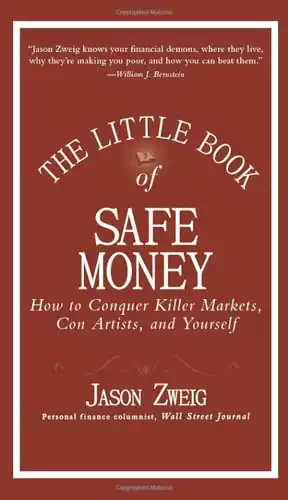Overview : The Little Book of Safe Money
-
Book Title: The Little Book of Safe Money
-
Author: Jason Zweig
-
Publication Date: November 2009
-
Rating: 4.5
-
price: $18.49
-
Pages: 640
About the Author
The Little Book of Safe Money: How to Conquer Killer Markets, Con Artists, and Yourself is authored by Jason Zweig, a renowned financial journalist and columnist for The Wall Street Journal. The book offers practical advice on managing risk, avoiding common investment pitfalls, and making sound financial decisions.
Introduction
In an era of economic uncertainty and volatile markets, Jason Zweig's "The Little Book of Safe Money" emerges as a beacon of financial wisdom. This comprehensive review explores how Zweig, a renowned Wall Street Journal columnist, offers invaluable insights into protecting and growing your wealth responsibly.
Book Summary
"The Little Book of Safe Money" is a concise yet powerful guide to navigating the complex world of personal finance and investing. Zweig's approach focuses on:
- Risk management in investing
- Debunking common financial myths
- Understanding market psychology
- Strategies for long-term financial security
The book's core message revolves around the importance of preserving capital while seeking sustainable growth, a philosophy that resonates deeply in today's unpredictable economic landscape.
Analysis of Key Themes
1. The Psychology of Investing
Zweig delves into the cognitive biases that often lead investors astray. He emphasizes the importance of emotional intelligence in financial decision-making, a crucial aspect often overlooked in traditional investment literature.
2. Demystifying Financial Jargon
One of the book's strengths lies in its ability to break down complex financial concepts into digestible information. Zweig's explanations of market trends, asset allocation, and risk assessment are particularly enlightening for both novice and experienced investors.
3. The Role of Technology in Modern Investing
While not extensively covered, Zweig touches on how technological advancements, including the rise of fintech and digital banking, are reshaping the investment landscape. This provides a contemporary context to his timeless financial principles.
Writing Style and Accessibility
Zweig's writing is characterized by its clarity and engaging tone. He masterfully weaves anecdotes and historical references into his financial advice, making the book both informative and enjoyable to read. This approach helps in demystifying complex topics like:
- Portfolio diversification
- Bond market dynamics
- Inflation hedging strategies
Strengths and Weaknesses
Strengths:
- Practical, actionable advice for investors of all levels
- Strong focus on risk management and capital preservation
- Insightful analysis of investor psychology
- Clear explanations of complex financial concepts
Weaknesses:
- May be too conservative for aggressive investors
- Limited coverage of emerging investment trends like cryptocurrencies
- Some examples may feel dated to younger readers
Comparison to Other Works
"The Little Book of Safe Money" stands out in the crowded field of personal finance literature. Unlike more technical works like Benjamin Graham's "The Intelligent Investor" or trend-focused books like "Rich Dad Poor Dad" by Robert Kiyosaki, Zweig's book strikes a balance between timeless wisdom and practical, modern-day application. Its approach to safe investing aligns well with the philosophies of other respected financial authors like John Bogle and Warren Buffett, emphasizing long-term thinking and prudent risk management.
Key Quotes
"The safest way to double your money is to fold it in half and put it in your pocket." - This quote encapsulates Zweig's emphasis on capital preservation. "Being a long-term investor is easy to say but hard to do." - Highlighting the challenge of maintaining discipline in investing.
Highlights from The Little Book of Safe Money
Focus on Safety: Prioritize preserving capital over chasing high returns.
Understand Risk: Recognize the difference between speculation and true investing.
Avoid Complex Investments: Stick to simple, transparent financial products that you understand.
Diversification is Key: Spread investments across different asset classes to reduce risk.
Beware of Financial Gurus: Rely on sound principles, not tips from so-called experts.
Control Emotions: Avoid making impulsive decisions driven by fear or greed.
Plan for the Long Term: Build wealth steadily with a disciplined, long-term approach.
Stay Informed: Continuously educate yourself about financial markets and products.
Conclusion
Jason Zweig's "The Little Book of Safe Money" is more than just a guide to safe investing; it's a roadmap to financial peace of mind. In a world where financial advice often leans towards the extreme, Zweig's balanced approach is refreshing and necessary. Whether you're a novice investor or a seasoned financial professional, this book offers valuable insights that can help fortify your financial future. For those looking to implement Zweig's strategies, consider starting with a well-diversified, low-cost index fund. [Affiliate Link: Vanguard Total Stock Market Index Fund] Remember, the path to financial security is not about finding the next big investment opportunity, but about making informed, prudent decisions consistently over time. "The Little Book of Safe Money" equips you with the knowledge and mindset to do just that.





